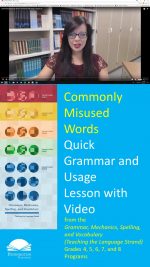Possessive Pronouns
Possessive Pronouns
Play the quick video lesson HERE and click the upper left back arrow to return to this lesson.
Common Core Language Standard 1
To possess means to own or control something. We might say that you possess a smart phone or you possess the ability to learn. Both nouns and pronouns can be in the possessive case because they can own or control something.
Today’s grammar and usage lesson is on possessive pronouns. Remember that a pronoun takes the place of a noun. A pronoun may also modify a noun.
Now let’s read the grammar and mechanics lesson and study the examples.
Possessive pronouns show ownership and may be used before a noun or without a noun.
Before a noun—my, your, his, her, its, our, your, their
When a possessive pronoun is used before a noun, it modifies the noun. The verb matches the noun, not the pronoun. Example: Our house seems small.
Without a noun—mine, yours, his, hers, ours, yours, theirs
When a possessive pronoun is used without a noun, the verb must match the noun which the pronoun represents. Example: Mary said that my jacket is nice, but hers is nicer.
Now circle or highlight what is right and revise what is wrong according to grammar and mechanics lesson.
Practice: We took our donations to the shelter. Their clothes were brand new, but my were used.
Let’s check the Practice Answers.
Grammar and Mechanics Practice Answers: We took our donations to the shelter. Their clothes were brand new, but mine were used.
Now let’s apply what we have learned.
Writing Application: Write your own sentences using a possessive pronoun before a noun and a possessive pronoun without a noun.
*****
Pennington Publishing Grammar Programs
Teaching Grammar, Usage, and Mechanics (Grades 4, 5, 6, 7, 8, and High School) are full-year, traditional, grade-level grammar, usage, and mechanics programs with plenty of remedial practice to help students catch up while they keep up with grade-level standards. Twice-per-week, 30-minute, no prep lessons in print or interactive Google slides with a fun secret agent theme. Simple sentence diagrams, mentor texts, video lessons, sentence dictations. Plenty of practice in the writing context. Includes biweekly tests and a final exam.
Grammar, Usage, and Mechanics Interactive Notebook (Grades 4‒8) is a full-year, no prep interactive notebook without all the mess. Twice-per-week, 30-minute, no prep grammar, usage, and mechanics lessons, formatted in Cornell Notes with cartoon response, writing application, 3D graphic organizers (easy cut and paste foldables), and great resource links. No need to create a teacher INB for student make-up work—it’s done for you! Plus, get remedial worksheets, biweekly tests, and a final exam.
Syntax in Reading and Writing is a function-based, sentence level syntax program, designed to build reading comprehension and increase writing sophistication. The 18 parts of speech, phrases, and clauses lessons are each leveled from basic (elementary) to advanced (middle and high school) and feature 5 lesson components (10–15 minutes each): 1. Learn It! 2. Identify It! 3. Explain It! (analysis of challenging sentences) 4. Revise It! (kernel sentences, sentence expansion, syntactic manipulation) 5. Create It! (Short writing application with the syntactic focus in different genre).
Get the Diagnostic Grammar, Usage, and Mechanics Assessments, Matrix, and Final Exam FREE Resource:








